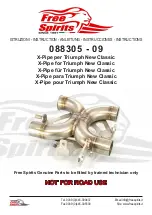
18
A Guide To Damper Tuning
The ultimate purpose of a shock is to work together with the spring to keep the tire on the track. In
compression (bump) to help control the movement of the wheel and in rebound to help absorb the
stored energy of the compressed spring.
Usually in rain or low grip situations allowing more bleed or less low speed damping is desirable to
delay tire loading upon initial roll.
In dry high grip conditions adding damping or restricting bleed will load the tire sooner upon initial roll
increasing platform stability.
A motorcycle with too much low speed damping will usually lack grip in change of directions, cannot
put power down in slower corners (wheel spin) and lack overall grip after initial turn in.
If traction is a problem coming off slow corners, reducing low speed damping or adding more bleed
will help weight transfer at the rear thus increasing traction.
One of the most important things to know about these adjusters is their relative position to one an-
other. If for instance you have the low speed set at 25 to 30 clicks (soft), the range of high speed
adjustment will be lessened. Or in the opposite direction, if the high speed is set at 0 to 1 (off soft),
the low speed adjustment range will be lessened.
Also, when making a big adjustment in high or low speed, the change will affect the other in a small
percentage. As an example, the high speed is set at (+4) and the low speed at (-6). Now you want to
set the low speed to (-2), this will also increase a percentage of the high speed force figure. By
dropping the high speed from (+4) to (+3) would compensate for this low speed change so the overall
damper curve would remain intact. The more experience you have with these the easier it will
become to recognize what changes can occur in relation to different valvings. The tendency of these
circuits to cross talk is greatly reduced in our new digressive CD piston (part # AS-76DIGCDUP).
The rebound adjuster consists of a needle metering flow across a hole. This metered flow bypasses
the main piston/shim assembly until flow is choked off. The shims then modulate the flow.
Depending on valving, there will be an affect on adjustment range. The softer the valving (A - B), the
less force range it will have. This is due to a lower pressure required to blow the valves on the main
piston. Obviously the heavier the valving (C - E), the more effective the bleed becomes. On digres-
sive pistons, pre-load also affects the range of adjustment.
F
O
R
C
E
F
O
R
C
E
VELOCITY (SHAFT SPEED)
LOW SPEED HIGH SPEED
VELOCITY (SHAFT SPEED)
LOW SPEED HIGH SPEED
Large Amplitude Change
Small Amplitude Change
Large Amplitude Change
Small Amplitude Change
LOW SPEED ADJUSTMENT EXAMPLE
HIGH SPEED ADJUSTMENT EXAMPLE
Содержание 8900 series
Страница 3: ...3 Notes ...
Страница 29: ...29 Damping Adjustments Figure 3 Figure 2 ...
Страница 34: ...34 Notes ...
















































